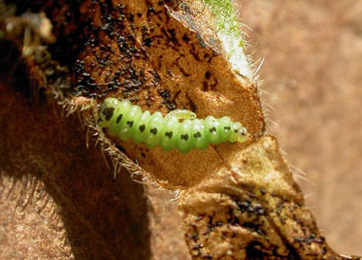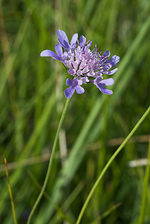|
||||||
|
SCABIOSA. Scabious. [Dipsacaceae] |
|
|
Seven species of Scabiosa are recorded in Britain. These include the native Small Scabious (S. columbaria) and the introduced Sweet Scabious (S. atropurpurea) and Pincushion-flower (S. caucasica). Seven British miners are recorded on Scabiosa. A key to the European miners recorded on Scabiosa is provided in Bladmineerders van Europa. |
|
Key for the identification of the known mines of British |
||
1a > Leaf-miner and case-bearer: A relatively large (12-15 mm), dark brown, lightly curved two-valved sheath case with a narrow ventral keel. Mouth angle 30-45. |
||
|
||
Coleophora conspicuella Zeller, 1849 [Lepidoptera: Coleophoridae]. |
||
1b > Leaf-miner, but not a case-bearer |
||
2a > Leaf-miner: A distinctive mine primarily above mid-rib, with irregular short lateral offshoots into leaf blade. Pupation external (Spencer, 1972: 51 (fig. 172), 55; Spencer, 1976: 270, 271 (fig. 486)). Branched, whitish, upper-surface corridor; main axis overlying the midrib; side branches overlying the main lateral veins. (In Campanula and Phyteuma the mine is much less branched, sometimes nothing more than a corridor on top of the midrib). Frass in rather long strings. Usually the mines begins as a long and narrow, shallow, tortuous lower-surface corridor that ends upon the midrib but otherwise is not associated with the leaf venation. Often this initial corridor is filled with callus, and then even less conspicuous. Pupation outside the mine. A linear mine on the upper surface, usually following the midrib and showing side branches along the veins. The frass is in strings. |
||
|
||
|
||
Liriomyza strigata (Meigen, 1830) [Diptera: Agromyzidae]. |
||
2b > Leaf-miner: Larvae feeding primarily along mid-rib, forming short lateral mines into the leaf blade. Pupation within the mid-rib. the corridors are short in Dipsacus, but longer in Knautia and Succisa. (Spencer, 1976: 480). The larvae essentially is a borer in the midrib, but makes from there narrow corridors into the blade. In the end also a corridor can be made on top of the midrib. Most frass is deposited within the midrib, to a lesser extent also in the corridors, at the point where they leave the midrib (Hering, 1957, 1967a). Pupation in the mine, generally in the basal part of the tunnel in the midrib, just below the upper epidermis. The larva feeds along the midrib, making short corridors into the leaf. |
||
|
||
Chromatomyia ramosa (Hendel, 1923) [Diptera: Agromyzidae]. |
||
2c > Leaf-miner: Mine linear and winding in upper surface. Pupation in the mine (Spencer, 1972b: 88). Upper-surface corridor, loops closely together. Frass in thread fragments or pearl string, seemingly lying in a central line. Pupation within the mine. |
||
|
||
Chromatomyia scabiosae (Hendel, 1935) [Diptera: Agromyzidae]. |
||
2d > Leaf-miner: A narrow winding linear mine generally near the apex of the leaf which assumes a striking purplish colour, making the mine itself difficult to detect. Mines have also been found in the sepals. Pupation takes place in a puparial cradle on the lower surface (Spencer, 1976: 510). Very long, often branched corridor, narrow till very end, for much of its length lower-surface, mostly in the apical part of the leaf. The corridor frequently intersects itself. Frass in discrete grains. Pupation in the mine, Around the mine the leaf almost always turns violet. |
||
|
||
Chromatomyia succisae (Hering, 1922) [Diptera: Agromyzidae]. |
||
2e > Leaf-miner: A long, whitish linear-blotch mine, frequently associated with the mid-rib (Spencer, 1976: 321 (fig. 583), 323). Unusually long (up to 16 cm), upper-surface, whitish corridor. Often the corridor crosses itself so repeatedly that a secondary blotch develops. Sometimes a few small grains of frass in the initial part of the mine. Otherwise the mine is either completely free from frass, or a few big lumps are deposited at the very end of the corridor. Pupation outside the mine. The mine is illustrated in the Encyclopedia of Life. |
||
|
||
Aulagromyza similis (Brischke, 1880) [Diptera: Agromyzidae]. |
||
2f > Leaf-miner: Full depth, transparent blotch. Oviposition site, at the leaf upper surface, covered by a brownish black drop of hardened secretion. Frass in granules or thread fragments. Pupation in the mine, not in a cocoon. |
||
 Trachys troglodytes larva, dorsal Image: © Steve Wullaert (Bladmineerders van Europa) |
||
|
||
Trachys troglodytes Gyllenhal, 1817 [Coleoptera: Buprestidae]. |
||
| Last updated 09-Jul-2020 Brian Pitkin | ||


